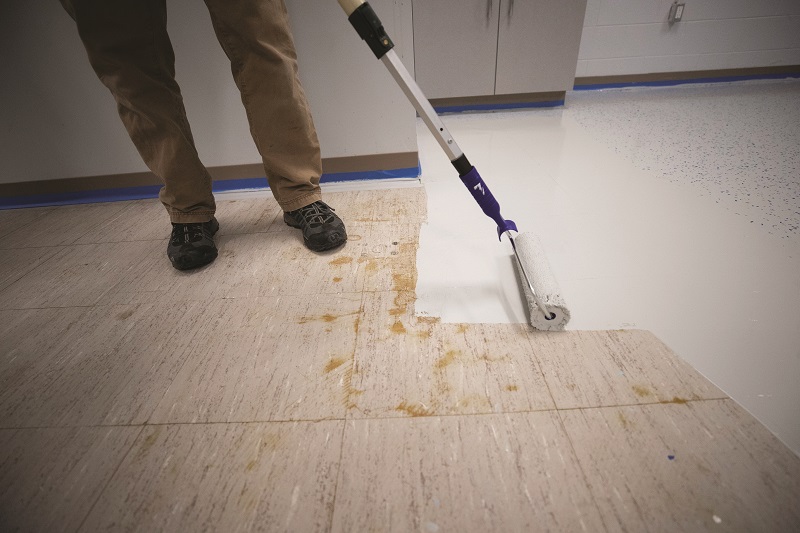Q. What is resilient flooring?
A. Resilient flooring includes PVC/vinyl, linoleum, and rubber, and can be defined as flooring that is firm, but also flexible.
It is considered an extremely-durable type of flooring that suits healthcare spaces and is ideal for high-traffic areas, and hence it used extensively in the sector for various reasons; largely due to its durability, and also because it is highly cost-effective, as well as its health and safety attributes.
Q: Why should healthcare organisations bring renovation of flooring onto their radar?
A. Surfaces in healthcare environments undergo a lot of activity.
Areas of heavy footfall in NHS trusts, transportation of heavy products and equipment, and increased levels of cleaning, all mean that surfaces underfoot are subject to significant wear.
And this diminishes the quality and safety of the flooring which, in turn, means that healthcare organisations must find a solution to overcome any issues.
When resilient floors become damaged, new flooring is often the first, and sometimes the only option considered; yet this is very limiting and can lead to unnecessary expense and disruption.
In fact, new flooring may be completely unnecessary, and it is not the only option.
If a floor looks in a very-bad state, it is often assumed that it must be ripped out and replaced.
However, no matter how bad the condition of a surface, it can often be totally transformed through renovation; a route that people may not have even considered would be possible, with results that look as good as new, without the huge expense or downtime of new flooring, renovation.
Q: What is the renovation process for resilient flooring in healthcare?
A. The renovation of existing resilient flooring is a far-more-efficient and effective process than installing new flooring; taking less than 24 hours, compared to several days required to fit a new floor.
Initially, old polish is removed and stripped from the floor’s surface. It is then abraded and cleaned, before the floor is coated with a new colour or chip combination to make it look as good as new.
Although the process may vary from supplier to supplier, expect the renovation process to be quick and easy.
For instance, after final application, it should be ready to use within 12 hours.
Q: What is the difference in price of renovation resilient flooring compared to a new installation?
A. Replacing surfaces with new flooring is expensive, both financially and time-wise due to the downtime required when certain areas are out of bounds to staff and patients for a period of time while the work takes place.
On the other hand, renovation of flooring can offer 50% less downtime, as well as reducing the initial replacement costs by up to 50%; saving significant funds from ever-stretched healthcare budgets.
Q: What are the key benefits of renovation over replacement?
A. Transforming a worn or degraded floor via renovation has major benefits over and above replacing the entire floor.
- It is more cost-effective: Renovation enables healthcare organisations to achieve the same result as fitting new flooring, but without the associated high costs of purchasing new and without having to endure a lengthy downtime during installation
- It improves hygiene and safety: The seamless, flat surface created by renovation means that joints, scratches, and other imperfections, where bacteria thrive, are completely removed and surfaces are sealed for further protection
- It is sustainable: When old flooring is removed, it produces dust and germs, and inevitably adds to landfill. Renovation is more environmentally sustainable and reduces an organisation’s carbon footprint considerably in comparison to floor replacement. In fact. The IVL Swedish Environmental Research Institute Report found that renovating resilient flooring surfaces provides more than 92% reduction in carbon footprint compared to floor replacement

Initially, old polish is removed and stripped from the old floor, before the surface is abraded and cleaned, then coated to make it look as good as new
Q: What difference does it make to patients and staff?
A. As the process is faster than replacement, any disruption to patients and staff is minimised.
If a floor is replaced for new, it’s not unusual for areas to be out of bounds for several days which causes inconvenience for everyone.
Renovation typically requires half the downtime of replacement.
Safety is another major benefit, and often anti-slip additives increase protection against slips and falls.
The pandemic has resulted in an increase in cleaning to minimise the spread of infection, and when a floor has been renovated with a flat surface, it requires less time to clean and fewer cleaning products; which again means both time and resource can be reallocated.
